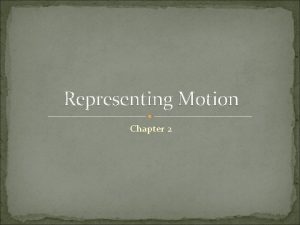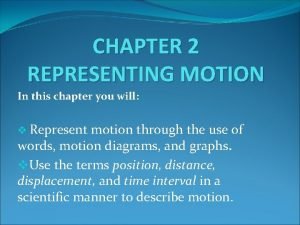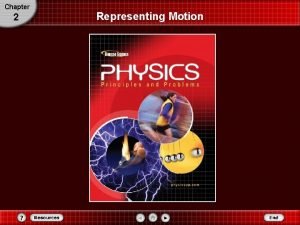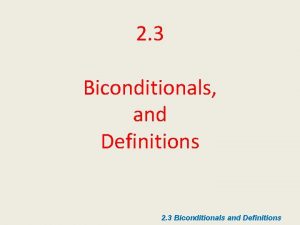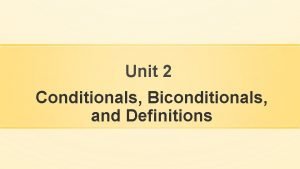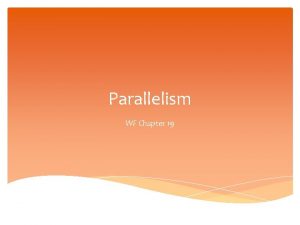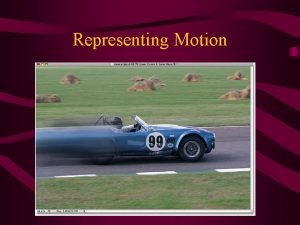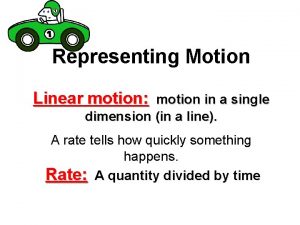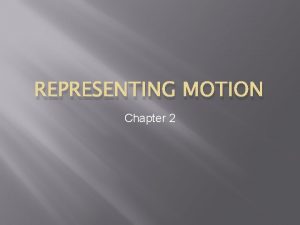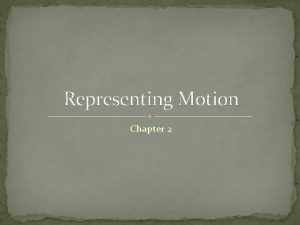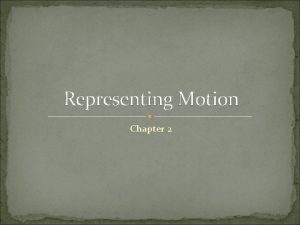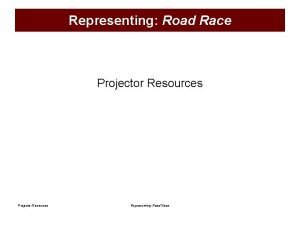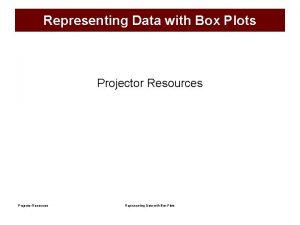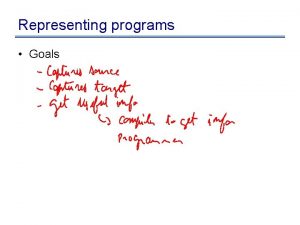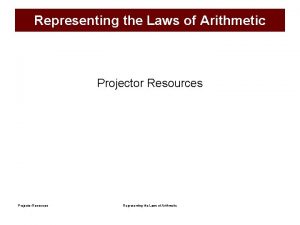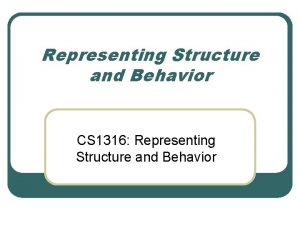Chapter 2 Representing Motion Definitions for Motion Unit
























































- Slides: 56

Chapter 2: Representing Motion

Definitions for Motion Unit • 1. Mechanics- Field of physics: the study of motion – 1 part: kinematics- description of how objects move – 2 nd part: dynamics- force, why objects move the way they do 2. Displacement- change in position of an object (from start to finish)(unit: m) (variable: x) equation: xf-xi 3. Distance- the total change in motion (unit: m) (variable: d) 4. Frame of Reference- A system for specifying the precise location of objects in space and time

One dimensional motion: a motion for which one direction (axis) is sufficient to describe it completely Examples: Two dimensional motion: a motion for which two directions are sufficient to describe it completely Examples: Three dimensional motion: a motion for which three directions are sufficient to describe it completely Examples:

Displacement is POSITIVE

Displacement is >0 if ground is the origin and UP is in the positive direction.

Speed vs. velocity • Speed = distance/time • Unit: m/s • Scalar: includes magnitude(numerical value) only • Velocity= displacement/time • Unit: m/s • Vector (includes the direction!): includes magnitude and direction Scalar or vector? a. 5 m b. 30 m/sec, East c. 5 mi. , North d. 20 degrees Celsius e. 256 bytes f. 4000 Calories

2 types of speed • Average speed: total distance/total time • Instantaneous speed: speed of an object at that very moment

Constant velocity • If velocity is constant (doesn’t change), the object must not change direction! Direction is part of velocity.

Average VELOCITY can be: POSITIVE NEGATIVE Or ZERO depending on displacement.

Average SPEED can only be POSITIVE since distance (the interval between two points regardless of the point of start and stop) is always positive.

Frame of Reference • A system for specifying the precise location of objects in space and time. • Must be a fixed (stationary) position. • Example: for train motion, frame of reference could be any train station along the path.

Section 2. 1 Picturing Motion Diagrams: Particle Model Another Example: Ticker-Tape Diagram Click image to view movie.

Section 2. 1 Section Check Question 1 Explain how applying the particle model produces a simplified version of a motion diagram?

Section 2. 1 Section Check Answer 1 A particle model is a simplified version of a motion diagram in which the object in motion is replaced by a series of single points. A runner is simplified into a point, rather than including arms and legs, etc.

Section Check 2. 1 Question 2 Which statement describes best the motion diagram of an object in motion? A. A graph of the time data on a horizontal axis and the position on a vertical axis. B. A series of images showing the positions of a moving object at equal time intervals. C. Diagram in which the object in motion is replaced by a series of single point. D. A diagram that tells us the location of zero point of the object in motion and the direction in which the object is moving.

Section 2. 2 Where and When? Coordinate Systems The length of how far an object is from the origin indicates its distance from the origin. The arrow points from the origin to the location of the moving object at a particular time.

Section 2. 2 Where and When? Coordinate Systems A position 9 m to the left of the tree, 5 m left of the origin, would be a negative position, as shown in the figure below.

Section 2. 2 Where and When? Vectors and Scalars Quantities that have both size, also called magnitude, and direction, are called vectors, and can be represented by arrows. Quantities that are just numbers without any direction, such as distance, time, or temperature, are called scalars.

Section 2. 2 Where and When? Vectors and Scalars The vector that represents the sum of the other two vectors is called the resultant. The resultant always points from the tail of the first vector to the tip of the last vector. Add vectors HEAD to TAIL!!

Section 2. 2 Where and When? Time Intervals and Displacement The difference between the initial and the final times is called the time interval. The common symbol for a time interval is ∆t, where the Greek letter delta, ∆, is used to represent a change in a quantity.

Section 2. 2 Where and When? Time Intervals and Displacement The figure below shows ∆d, an arrow drawn from the runner’s position at the tree to his position at the lamppost. The change in position during the time interval between ti and tf is called displacement.

Section 2. 2 Where and When? Time Intervals and Displacement To subtract vectors, reverse the subtracted vector and then add the two vectors. This is because A – B = A + (–B). The figure a below shows two vectors, A, 4 cm long pointing east, and B, 1 cm long also pointing east. Figure b shows –B, which is 1 cm long pointing west. The resultant of A and –B is 3 cm long pointing east.

Section 2. 2 Where and When? Time Intervals and Displacement To determine the length and direction of the displacement vector, ∆d = df − di, draw −di, which is di reversed. Then draw df and copy −di with its tail at df’s tip. Add df and −di.

Section 2. 2 Section Check Question 1 Differentiate between scalar and vector quantities?

Section 2. 2 Section Check Answer 1 Quantities that have both magnitude and direction are called vectors, and can be represented by arrows. Quantities that are just numbers without any direction, such as time, are called scalars.

Section Check 2. 2 Question 2 What is displacement? A. The vector drawn from the initial position to the final position of the motion in a coordinate system. B. The length of the distance between the initial position and the final position of the motion in a coordinate system. C. The amount by which the object is displaced from the initial position. D. The amount by which the object moved from the initial position.

Section 2. 2 Section Check Answer 2 Answer: A Reason: Options B, C, and D are all defining the distance of the motion and not the displacement. Displacement is a vector drawn from the starting position to the final position.

Section 2. 2 Section Check Question 3 Refer the adjoining figure and calculate the time taken by the car to travel from one signal to another signal? • Insert the figure shown for question 4. A. 20 min C. 25 min B. 45 min D. 5 min

Section Check 2. 2 Answer 3 Answer: C Reason: Time interval t = tf - ti Here tf = 01: 45 and ti = 01: 20 Therefore, t = 25 min

Section 2. 3 Position-Time Graphs Position Time Graphs Click image to view movie.

Section 2. 3 Position-Time Graphs Using a Graph to Find Out Where and When The data in the table can be presented by plotting the time data on a horizontal axis and the position data on a vertical axis, which is called a position-time graph.

Section 2. 3 Position-Time Graphs Using a Graph to Find Out Where and When The symbol d represents the instantaneous position of the object—the position at a particular instant.

Section 2. 3 Position-Time Graphs Equivalent Representations Words, pictorial representations, motion diagrams, data tables, and position-time graphs are all representations that are equivalent. They all contain the same information about an object’s motion.

Section 2. 3 Position-Time Graphs Considering the Motion of Multiple Objects In the graph, when and where does runner B pass runner A?

Section 2. 3 Position-Time Graphs Considering the Motion of Multiple Objects These lines intersect at 45. 0 s and at about 190 m.

Section 2. 3 Section Check Question 1 A position-time graph of an athlete winning the 100 -m run is shown. Estimate the time taken by the athlete to reach 65 m. A. 6. 0 s C. 5. 5 s B. 6. 5 s D. 7. 0 s

Section 2. 3 Section Check Answer 1 Answer: B Reason: Draw a horizontal line from the position of 65 m to the line of best fit. Draw a vertical line to touch the time axis from the point of intersection of the horizontal line and line of best fit. Note the time where the vertical line crosses the time axis. This is the estimated time taken by the athlete to reach 65 m.

Section 2. 3 Section Check Question 2 A position-time graph of an athlete winning the 100 -m run is shown. What was the instantaneous position of the athlete at 2. 5 s? A. 15 m C. 25 m B. 20 m D. 30 m

Section 2. 3 Section Check Answer 2 Answer: C Reason: Draw a vertical line from the position of 2. 5 m to the line of best fit. Draw a horizontal line to touch the position axis from the point of intersection of the vertical line and line of best fit. Note the position where the horizontal line crosses the position axis. This is the instantaneous position of the athlete at 2. 5 s.

Section 2. 3 Section Check Question 3 From the following position-time graph of two brothers running a 100 -m run, analyze at what time do both brothers have the same position. The smaller brother started the race from the 20 -m mark.

Section 2. 3 Section Check Answer 3 The two brothers meet at 6 s. In the figure, we find the intersection of line representing the motion of one brother with the line representing the motion of other brother. These lines intersect at 6 s and at 60 m.

Section Graphing Speed and Velocity 2. 4 Velocity Suppose you recorded two joggers on one motion diagram, as shown in the below figure. From one frame to the next, you can see that the position of the jogger in red shorts changes more than that of the one wearing blue. SKETCH Pos. vs. Time

Section Graphing Speed and Velocity 2. 4 Velocity In other words, for a fixed time interval, the displacement, ∆d, is greater for the jogger in red because she is moving faster. She covers a larger distance than the jogger in blue does in the same amount of time. Now, suppose that each jogger travels 100 m. The time interval, ∆t, would be smaller for the jogger in red than for the one in blue.

Section 2. 4 Graphing Speed and Velocity Average Velocity: Slope of line in Position vs. Time Graph The slopes of the two lines are found as follows:

Section 2. 4 Average Velocity It is a common misconception to say that the slope of a positiontime graph gives the speed of the object. The slope of the position-time graph on the right is – 5. 0 m/s. It indicates the average velocity of the object and not its speed. The object moves in the negative direction at a rate of 5. 0 m/s. The absolute value of the slope of a position-time graph tells you the average speed of the object, that is, how fast the object is moving.

Section 2. 4 How Fast? Average Speed The graph describes the motion of a student riding his skateboard along a smooth, pedestrian-free sidewalk. What is his average velocity? What is his average speed?

Section How Fast? 2. 4 Average Speed Step 1: Analyze and Sketch the Problem – Identify the coordinate system of the graph. Step 2: Solve for the Unknown – Find the average velocity using two points on the line. Step 3: Evaluate the Answer Do the signs make sense? Are the units correct?

Section 2. 4 How Fast? Example Problem Substitute d 2 = 12. 0 m, d 1 = 6. 0 m, t 2 = 8. 0 s, t 1 = 4. 0 s:

Section How Fast? 2. 4 Using Equations Any time you graph a straight line, you can find an equation to describe it. Based on the information shown in the table, the equation y = mx + b becomes d = t + di, or, by inserting the values of the constants, d = (– 5. 0 m/s)t + 20. 0 m. You cannot set two items with different units equal to each other in an equation.

Section How Fast? 2. 4 Using Equations An object’s position is equal to the average velocity multiplied by time plus the initial position. Equation of Motion for Average Velocity This equation gives you another way to represent the motion of an object. Note that once a coordinate system is chosen, the direction of d is specified by positive and negative values, and the boldface notation can be dispensed with, as in “d-axis. ”

Section Check 2. 4 Question 1 Which of the following statement defines the velocity of the object’s motion? A. The ratio of the distance covered by an object to the respective time interval. B. The rate at which distance is covered. C. The distance moved by a moving body in unit time. D. The ratio of the displacement of an object to the respective time interval.

Section 2. 4 Section Check Answer 1 Answer: D Reason: Options A, B, and C define the speed of the object’s motion. Velocity of a moving object is defined as the ratio of the displacement ( d) to the time interval ( t).

Section Check 2. 4 Question 2 Which of the statements given below is correct? A. Average velocity cannot have a negative value. B. Average velocity is a scalar quantity. C. Average velocity is a vector quantity. D. Average velocity is the absolute value of the slope of a positiontime graph.

Section 2. 4 Section Check Answer 2 Answer: C Reason: Average velocity is a vector quantity, whereas all other statements are true for scalar quantities.

Section 2. 4 Section Check Question 3 The position-time graph of a car moving on a street is as given here. What is the average velocity of the car? A. 2. 5 m/s C. 2 m/s B. 5 m/s D. 10 m/s

Section 2. 4 Section Check Answer 3 Answer: C Reason: Average velocity of an object is the slope of the positiontime graph.
 Representing motion physics answers chapter 2
Representing motion physics answers chapter 2 Picturing motion
Picturing motion What is the purpose of drawing a motion diagram
What is the purpose of drawing a motion diagram Representing motion
Representing motion Range of motion def
Range of motion def Vocabulary workshop level f unit 10
Vocabulary workshop level f unit 10 Level f unit 1
Level f unit 1 Unit 3 lesson 2 biconditionals and definitions
Unit 3 lesson 2 biconditionals and definitions Lesson 2 biconditionals and definitions
Lesson 2 biconditionals and definitions Chapter 19 matching words with definitions
Chapter 19 matching words with definitions Chapter 13 sentence check 2 answer key
Chapter 13 sentence check 2 answer key Unit 10, unit 10 review tests, unit 10 general test
Unit 10, unit 10 review tests, unit 10 general test Chapter 2 section 1 describing motion answer key
Chapter 2 section 1 describing motion answer key What is acceleration
What is acceleration Section 1 describing motion answer key
Section 1 describing motion answer key Kontinuitetshantering i praktiken
Kontinuitetshantering i praktiken Novell typiska drag
Novell typiska drag Nationell inriktning för artificiell intelligens
Nationell inriktning för artificiell intelligens Vad står k.r.å.k.a.n för
Vad står k.r.å.k.a.n för Varför kallas perioden 1918-1939 för mellankrigstiden?
Varför kallas perioden 1918-1939 för mellankrigstiden? En lathund för arbete med kontinuitetshantering
En lathund för arbete med kontinuitetshantering Kassaregister ideell förening
Kassaregister ideell förening Tidböcker
Tidböcker A gastrica
A gastrica Vad är densitet
Vad är densitet Datorkunskap för nybörjare
Datorkunskap för nybörjare Stig kerman
Stig kerman Mall debattartikel
Mall debattartikel Magnetsjukhus
Magnetsjukhus Nyckelkompetenser för livslångt lärande
Nyckelkompetenser för livslångt lärande Påbyggnader för flakfordon
Påbyggnader för flakfordon Formel för lufttryck
Formel för lufttryck Publik sektor
Publik sektor Bo bergman jag fryser om dina händer
Bo bergman jag fryser om dina händer Presentera för publik crossboss
Presentera för publik crossboss Teckenspråk minoritetsspråk argument
Teckenspråk minoritetsspråk argument Kanaans land
Kanaans land Treserva lathund
Treserva lathund Luftstrupen för medicinare
Luftstrupen för medicinare Bästa kameran för astrofoto
Bästa kameran för astrofoto Centrum för kunskap och säkerhet
Centrum för kunskap och säkerhet Verifikationsplan
Verifikationsplan Bra mat för unga idrottare
Bra mat för unga idrottare Verktyg för automatisering av utbetalningar
Verktyg för automatisering av utbetalningar Rutin för avvikelsehantering
Rutin för avvikelsehantering Smärtskolan kunskap för livet
Smärtskolan kunskap för livet Ministerstyre för och nackdelar
Ministerstyre för och nackdelar Tack för att ni har lyssnat
Tack för att ni har lyssnat Referatmarkering
Referatmarkering Redogör för vad psykologi är
Redogör för vad psykologi är Borstål, egenskaper
Borstål, egenskaper Tack för att ni har lyssnat
Tack för att ni har lyssnat Borra hål för knoppar
Borra hål för knoppar Vilken grundregel finns det för tronföljden i sverige?
Vilken grundregel finns det för tronföljden i sverige? Beräkna standardavvikelse
Beräkna standardavvikelse Tack för att ni har lyssnat
Tack för att ni har lyssnat Steg för steg rita
Steg för steg rita

